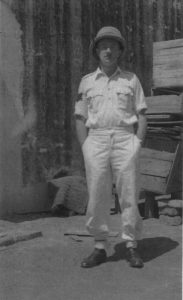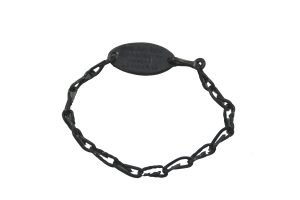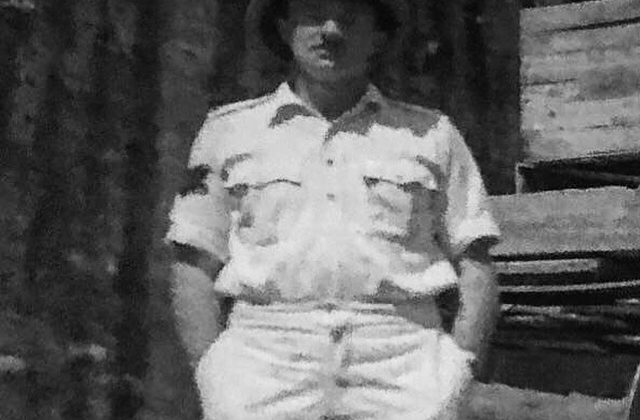Recently in the museum a new exhibit has been opened up, the exhibit has been dedicated to the possessions of Colour Serjeant Edward Ridge, which were donated by his family. What drew me to his exhibit was the collections unusual and deeply personal items which help tell his war time story. I find by looking at the stories behind the event it can give a deeper understanding of history, rather than just looking at the events which unfold, i.e. looking at just battles.

Captured in North Africa
Ridge was captured near Bir-el Harmat, North Africa in the June of 1942 after the battle of Gazala. When I read this information which was given next to his possessions, a number of questions went through my head, firstly where did he go once captured, and my other question, which I’m sure I am not the only person wondering… What was Colour Serjeant Edward Ridge doing in North Africa in the first place?
Of course, the war is known as “WORLD WAR 2“implying that it took place and effected the majority of the world. But often in schools we only really learn about events like the Battle of Britain and the fighting on the Western Front, events which are all equally important to remember, and are often closer to home.
After doing a bit of research to help me get a greater understanding of Ridge’s story this is my very brief understanding of what occurred at the beginning of WW2 in North Africa and what events lead to Colour Serjeant Edward Ridge’s capture by Axis forces.
The North African Campaign
Libya had been an Italian colony for several decades and British forces had been in neighbouring Egypt since 1882. Once Italy had declared war on the Allied forces in 1940, conflict between the neighbouring countries started almost immediately. One of the key axis figures in the North African campaign is that of Erwin Rommel (nicknamed the “Desert Fox”). An experienced General Field Marshal, who lead the attack on the allied occupied village of Gazala. In short, the advance was successful, and Rommel exploited the success by pursuing the British into Egypt, denying them time to recover from the defeat. This then lead to the loss of 50,000 men either killed, wounded or captured, including c. 35,000 prisoners taken at Tobruk.
A Prisoner of War in Italy
Amongst those 35,000 prisoners Colour Serjeant Edward Ridge and some of his fellow men, were taken to Campo Concentramento, more commonly known as ‘Fossoli Camp’ in Italy.
In the early years of the war the camp mainly held POWS. Conditions at the beginning of the war in Fossli were comparatively better than that of the extermination camps found in the rest of eastern Europe, with living conditions for the prisoners in accordance with international law and where representatives of the Red Cross visited regularly. This isn’t to say that life in the camps was easy for the prisoners, it’s impossible to fully comprehend how the soldiers of the DCLI dealt with the situation they were placed in.
After Italy surrendered to the Allied forces in 1943 Germany took control of large areas of Italy and took control of many of the camps, often turning them from POW camps to Concentration Camps (like Fossoli Camp). We know that Edward Ridge was moved to a larger camp in Germany.
In the exhibit you can see a message from the Vatican Radio, a transcription of a message to Ridge’s family, this was common during the Second World War as the Vatican City remained neutral under the directions of the Holy See and Pope Pius x11. Reading out the messages of POWS was all part of the Vatican City’s humanitarian work during the war, however towards the end of the war the sort of messages and war related material Ridge’s family received, would have been censored, as the Italian government were concerned about vital military information being leaked via the radio.
It’s difficult to imagine how Ridge’s family must have felt after hearing this message, it’s possible that for years they may have not heard from their husband/father, they may have even presumed him to be dead. Today in the 21st century we are all so connected with the introduction of the internet it’s difficult to imagine the impact emotionally this could have caused to the family. Just hearing those few words could have brought unimaginable joy and hope to the family.
His Daughters Identity Bracelet
Amongst Ridge’s items there is also a small child’s identity bracelet, this bracelet belonged to Theresa Ridge, Colour Serjeant Edward Ridge’s daughter. Identity bracelets were given to children who lived in areas which were at great risk of being bombed but were not evacuated. The bracelet would contain the child’s name, address and next of kin. This was done to ensure that in an event that a child was separated from his/her family then they could be reunited, or in a worst case, be identified if they had been killed in a bombing along with their family.

The majority of children would be sent out into the countryside (over 1.5 million were evacuated), if a parent couldn’t part with their children then they could keep them at home, despite the perpetual risk of bombing and the constant government encouragement to send people at risk away. Children would be encouraged to learn the information on their identity car or bracelet off-by-heart, in case it was lost during an air-raid.
Whilst researching the children of the blitz I learnt that between September 1939 to September 1940 at a rate of two and a half thousand every week, children who had been safely evacuated to the countryside were getting homesick and returning into the big cities which they had longed for. In the early years of the war the public knew about the fighting in other corners of the globe but didn’t believe it would affect them at home. The food rationing of the Blitz started in 1940, so before this, parents believed it was safe to bring children home.
Wartime Britain in the cities was a dangerous time for civilians, the Blitz campaigns themselves claimed the lives of around 32,000 people, despite the many lives saved by evacuating children, 1 in 10 deaths caused by Bombing in the city was that of a child’s death. This unsettling statistic shows how vital items like identity bracelets were to the families of the Blitz.
After doing research to get a greater understanding of Ridge’s life, I have learnt one thing that at any key event in history, it’s the people behind the scenes that really make the difference. Whilst Colour Serjeant Edward Ridge may have not be remembered like figures such as Winston Churchill, or Herman Goering (remembered for all the wrong reasons), without millions of soldiers such as Ridge and their families back at home, the outcome of WW2 would have been quite different.
By Meggie Slater


